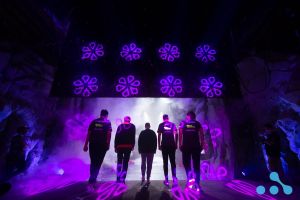This article is sponsored by WePlay Holding.
The world’s livestreaming audience in 2021 has reached a total of 729 million people, according to games and esports analytics platform Newzoo.
With each passing year, the number of both new viewers and esports enthusiasts is growing and esports has slowly become a cultural phenomenon for both younger and older audiences.
Esports tournaments have long left the cramped space of internet cafés, now hosting large, international events that attract millions of spectators both in-person and from behind the screen. With AR integration, VR technology, and graphics of all kinds, tournament operators use everything at their disposal to turn their broadcasts into real spectacles.
This means that different production teams also use varying methods and technology to get their productions running. That could simply be a different brand of cameras being used to capture the stage action, a preference in audio equipment like soundboards to deal with a multitude of incoming audio feeds, or distributing data in multiple ways to provide the most stable and effective transmissions.
As event production continues to evolve in esports, WePlay Esports tech engineer lead Anatoliy Ryzhkin spoke with Dot Esports about the creation of tournaments and broadcasts, developing them for fans in-person and at home, and how WePlay Esports works its magic behind the scenes.





How do you deal with video and audio latency?
Ryzhkin: We use soundboards to work with audio signal latency. There are quite a lot of options on the market to choose from. Unfortunately, the range of video signal latency devices is much smaller, and the more frames a device can hold, the higher its price.
Are video and audio signals distributed as IP or are SDI and AES used as well?
Like most studios, we do not focus exclusively on any one signal transmission format, but use different signal types depending on the task—most often, SDI and IP. SDI is considered one of the most stable and fault-tolerant video signal transmission formats, so in the WePlay Esports studio, it is used as the main option. However, many devices today are developed on the basis of IP technology, which is why our specialists also use this type of transmission. AES is also used, but less often.
What type of networks, like ethernet or fiber, are used?
Both ethernet and fiber—the choice depends on the task at hand and the conditions with which you have to work. Fiber has a higher bandwidth when working over long distances. In addition, using this type of network helps avoid a number of inconveniences that may arise when using an ethernet cable (damage, breakage). So, if we need to transmit a signal over a long distance, we often choose fiber. Within the studio, where all devices are located in proximity to one another, we use ethernet.
There are also cases where we use more than one type at the same time. For example, during WePlay AniMajor, an international Dota 2 tournament organized by our company, both fiber and ethernet were used.
What type of network topologies, such as mesh or leaf-spine, are used?
We often use the tree and star topologies. They are more in line with our needs. The mesh type is also not bad, but we don’t use it in our work—at least for now.
How are IP video and audio streams managed in terms of control and data requirements?
Since our team mainly works with SDI signals, we do not have so many IP video and audio streams that we need to monitor this data. We are currently considering options for using this technology within the studio and are studying it in more detail, including the control requirements.
What type of video transport formats are used? For example, RTP, SMPTE ST2110, and NDI.
Our studio uses several types of video transport formats since there are different requirements for the platforms we work with. For example, the RTMP format is used to transfer videos to streaming services such as Twitch and YouTube. Some of our broadcast partners work exclusively with SRT technology, which is why we transmit video in this format. For now, we use NDI to monitor content, view and output certain video signals to devices. We often use WebRTC for video conferences.
What type of video and audio compression do you use?
The H.264 and H.265 formats. They are both licensed and do a good job of compressing the video stream in a short time while maintaining its high quality.







Published: Sep 20, 2021 08:48 am